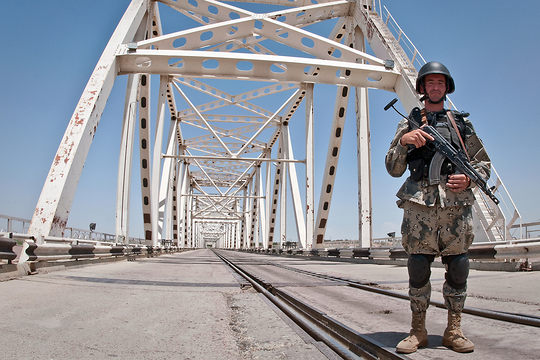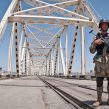
NDN ‘Reverse Transit,’ Uzbekistan and the Failure of Western Grand Strategy (Part Two)
Publication: Eurasia Daily Monitor Volume: 10 Issue: 61
By:

The drawdown of North Atlantic Treaty Organization (NATO) combat forces from Afghanistan by 2014 will limit the future potential of the Northern Distribution Network (NDN). Moreover, the withdrawal has left defense planning staffs among International Security Assistance Force (ISAF) members trying to resolve the conundrum of moving military hardware out of Afghanistan that had taken more than a decade to deploy. Although this has resulted in numerous bilateral agreements between NATO members and Kazakhstan, Kyrgyzstan, Tajikistan and Uzbekistan, the NDN as a thriving series of routes could essentially wither on the vine of the NATO drawdown (Interfax, March 6; Nezavisimaya Gazeta, May 12, 2012).
Still, Central Asian participants in the NDN have shown undying hope to benefit from entering new arrangements tied to NDN “reverse transit.” These benefits, however, may lie more in the unconnected realm of receiving weapons and equipment transfers to help boost domestic security, than in boosting commerce through NDN spin-offs (see EDM, February 1).
Uzbekistan is highly likely to benefit in terms of individual NATO members entering bilateral military equipment transfer agreements; the United States and the United Kingdom have already agreed to such deals, with the latter now under consideration by the UK Parliament. This is aimed at boosting Uzbekistan’s security, mainly tied to enhancing its border protection capabilities. By February 2013, the UK seemed poised to enter such arrangements with Tashkent. Phillip Hammond, the UK defense secretary, indicated that the British government has no reservations concerning equipment transfers to Uzbekistan linked to the Afghanistan drawdown: “We have a general principle that we don’t transfer equipment that might be used for internal repression, but the Uzbeks [sic] have a clear challenge in the post-2014 period around their long border with Afghanistan. This is not just against an insurgency or Islamists, but also against crime and narcotics” (Interfax, February 21). London will transfer to Tashkent Land Rover spares and a number of trucks as part of its wider equipment transfer strategy. Paradoxically, the countries that need more equipment, such as Kyrgyzstan and Tajikistan, will receive less than Kazakhstan and Uzbekistan in London’s plans.
Kazakhstan’s government, on the other hand, has shown less interest in the Central Asian scramble for weapons and equipment transfers, and remains more narrowly focused on assisting in the drawdown. The list of equipment transfers requested by Astana mainly covers engineering and logistics transfers—suggesting there may be greater awareness within Kazakhstan’s defense planning staffs on precisely where its equipment weaknesses are located. It was the first country in Central Asia to sign overland reverse transit agreements with the US, UK and other NATO members to facilitate this process. In January 2013, Astana signed a deal with Paris to assist in withdrawing non-lethal elements of French military hardware and equipment from Afghanistan by air to Shymkent and then overland through the NDN, northward to Baltic Sea ports. Paris has not disclosed the reasons for preferring Kazakhstan to the more obvious and strategic route through Uzbekistan (Interfax, January 30).
Seen from Tashkent, the NDN offers political and economic advantages. It increases the appreciation in Washington and other NATO capitals for a regime that has often been criticized on human rights or other grounds, allowing President Islam Karimov to push the image of Uzbekistan as a “strategic partner” for selected Western governments. In February 2012, the Obama administration secured an end to the de facto US arms embargo on Uzbekistan. Sources close to a recent bilateral meeting told Jamestown that during a visit by senior Uzbekistani government officials to Washington on March 14, the US agreed to supply Uzbekistan with 20 Raven unmanned aerial vehicles (UAVs) to boost border security. The NDN increases the volume of logistical transit through Uzbekistan, but this has often been slowed due to disagreements between Tashkent and its Central Asian neighbors, or its economic advantages hamstrung by local corruption networks or unfathomable bureaucracy. How many Western truck drivers, for instance, would contribute to the local economy during their pit stops through Uzbekistan, given the noticeable lack of ATMs even in major cities?
NDN has failed to generate an appetite among the Central Asian governments to become stakeholders in an essentially foreign and alien concept—the idea of uniting around a common economic purpose and forging a modern Silk Road. This also has its more regional competitors, such as Russian President Vladimir Putin’s aspiration to forge a Eurasian Union, which critics argue represents a scaled-down version of the Soviet Union. Already, economically, through the existing Customs Union, Kazakhstan is more economically tied to Russia and Belarus than to its Central Asian neighbors. Much of Uzbekistan’s trade, on the other hand, depends on access south to markets including Iran (Interfax, March 6).
These grand schemes, tied to NDN-planning and conceived in Western capitals or even espoused by Western experts on the “region,” die a harsh death when faced with the realities of a disparate group of countries that actually lack the main characteristics of a “region”—in the sense that this term is understood in Western policymaking circles. Such dramatic outcomes for the NDN, set to scale back after 2014, will confront NATO and Alliance members with a whole series of questions after the Afghanistan drawdown that many, if not all, may choose to ignore. But the origins of these failures of grand schemes lie in Western governments’ approaches to and limited understanding of Central Asia, and less in the under-developed local economies.




